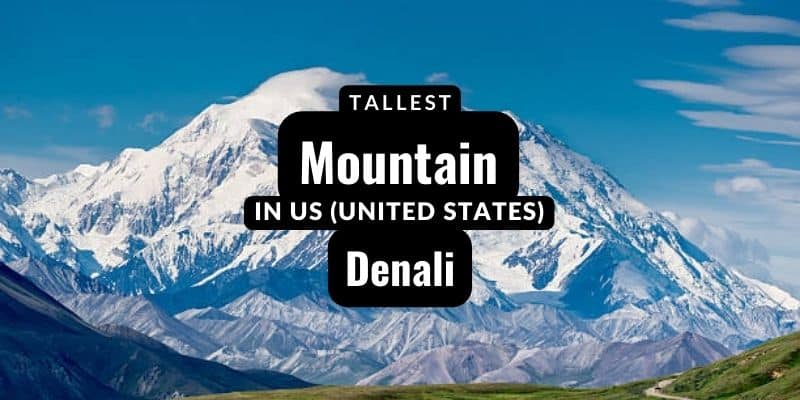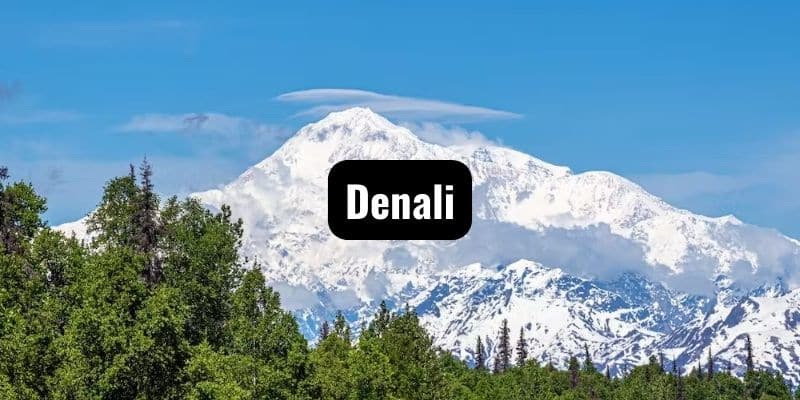Tallest Mountain In US: Denali Mountain In The United States

Denali Mountain, formerly known as Mount McKinley,. It is the highest peak in North America and the tallest mountain in the United States. Situated in the Alaska Range, Denali holds a significant place in the Alaskan culture, ecology, and mountaineering history.
What is Denali Mountain and Its Significance?

History of Denali Mountain
Denali, meaning “the high one” in the native Athabascan language. It has a rich history dating back to the indigenous Alaskan people who have revered this majestic peak for centuries. In 1896, a gold prospector named it “Mount McKinley” in support of the presidential candidate of the time. However, in 2015, the U.S. officially reinstated its native name, Denali, as a sign of respect to the native culture. The geological formation of Denali traces back millions of years, sculpted by natural forces into its current towering form.
Read Also: Discover A wide list of tallest montains in the US
Significance of Denali in the Native Alaskan Culture
For the native Alaskan tribes, Denali holds immense cultural and spiritual significance. It is considered a sacred place, featuring prominently in their folklore, traditions, and way of life. Throughout history, the mountain has been a symbol of strength, resilience, and spiritual connection for the indigenous people of Alaska.
Ecological Importance of Denali in the Alaska Range
Denali stands as the centerpiece of the eponymous national park and preserve, encompassing six million acres of pristine wilderness. Its diverse ecosystems support a remarkable array of flora and fauna, including grizzly bears, caribou, Dall sheep, and countless species of alpine plants. The mountain’s ecological importance extends to the delicate balance of the Alaska Range. It contributes to the broader conservation efforts in the region.
How High is Denali?
Comparison with Other Major Summits
Denali’s elevation of 20,310 feet (6,190 meters) above sea level makes it one of the highest major summits globally. It surpasses Mount Whitney, the tallest mountain in the contiguous United States, by a significant margin, cementing its status as the highest peak in the US. However, it falls short of the absolute highest point on Earth held by Mount Everest and the highest peak in the Americas, Aconcagua.
Elevation and Geographic Location
Situated in south-central Alaska, Denali’s geographic coordinates position it within the breathtaking expanse of the Alaska Range. Its colossal stature and geographic isolation contribute to the extreme weather conditions and unique climate patterns experienced at such high elevations.
Climate and Weather Conditions at Denali
Denali’s summit is renowned for its harsh and unpredictable weather, characterized by severe storms, high winds, and sub-zero temperatures. Mountaineers attempting to scale this formidable peak must contend with some of the most challenging weather conditions in the world. It adds to the complexity and danger of the climb.
Where is Denali Located and How to Reach There?
Geographical Location of Denali in Alaska
Denali is located in the heart of Denali National Park and Preserve in Alaska. It offer visitors an opportunity to experience the natural grandeur and diverse ecosystems of this remote wilderness. The park’s geographical position amidst the Alaska Range enhances its allure for adventurers, nature enthusiasts, and researchers alike.
Access Routes and Transportation Options
Reaching Denali and its environs typically involves air travel to established hubs in Alaska, followed by ground transportation to the park. A variety of access routes and transportation options, including guided tours, bus services, and private vehicle access, facilitate visitors’ exploration of this renowned national park.
Information on Denali National Park
Denali National Park and Preserve, recognized for its remarkable biodiversity and scenic beauty, offers a range of outdoor activities such as hiking, wildlife viewing, and camping. The park’s visitor facilities and educational programs contribute to the conservation and appreciation of Denali’s natural heritage.
Can Denali Mountain be Climbed?
Challenges and Risks in Climbing Denali
Climbing Denali presents a formidable challenge due to its extreme elevation, harsh climate, and technical difficulty. Mountaineers face significant physical and mental obstacles, including altitude sickness, crevasse navigation, and the threat of avalanches. The inherent risks associated with high-altitude mountaineering demand meticulous preparation, skill, and experience to mitigate potential dangers.
Popular Routes for Climbing Denali
Several established routes lead climbers to Denali’s summit, each presenting varying levels of technical challenge and exposure. The West Buttress route, renowned for its accessibility and relatively safe conditions, remains the most frequently chosen path for ascending this iconic mountain. Advanced routes such as the Cassin Ridge and the Slovak Direct offer experienced climbers a more demanding and adventurous ascent.
Experiences of Mountaineers Who Have Climbed Denali
Mountaineers who have conquered Denali often recount tales of perseverance, triumph, and unwavering determination amid the daunting challenges encountered during their ascent. Their firsthand experiences provide valuable insights into the physical and emotional demands of scaling one of the world’s most imposing peaks, further igniting the spirit of adventure and exploration in aspiring mountaineers.
Comparison with Other Tallest Mountains in the United States
Comparison with Mount Whitney, the Tallest Mountain in the 48 States
Denali’s grandeur surpasses that of Mount Whitney, the highest peak in the contiguous United States, by a substantial margin, emphasizing its unparalleled height and prominence within the American landscape. While both mountains offer unique and compelling climbing experiences, Denali’s extreme altitude and challenging conditions set it apart as a preeminent mountaineering destination.
Differences in Geography and Geological Characteristics
Denali’s location in the Alaska Range infuses it with a distinct geological makeup and ecological diversity not found in other US mountain ranges. The rugged terrain and alpine environments surrounding Denali contrast with the geological characteristics of other prominent peaks, contributing to the unparalleled allure and ecological significance of this iconic mountain.
Ecological Diversity and Conservation Efforts
Denali’s pivotal role in the preservation of the Alaska Range’s rich biodiversity underscores its broader ecological significance. The conservation efforts within and around Denali National Park and Preserve serve as a testament to the collective commitment to safeguarding this invaluable natural heritage, ensuring the continued protection and appreciation of this extraordinary alpine ecosystem.
Conclusion
Denali’s status as the tallest mountain in the United States Department of the Interior lists it among the highest major summits of the world. It remains a symbol of natural grandeur, attracting visitors from all over the globe who seek to marvel at the highest point of the San Sangre de Cristo Mountains and the mountain ranges that stretch across the horizon.
FAQs
The tallest mountain in the United States is Denali, also known as Mount McKinley. It is located in the Alaska Range and is the highest peak in North America.
Denali is approximately 20,310 feet (6,190 meters) tall, making it one of the tallest mountains in the world.
Other notable mountains in the Alaska Range include Mount Foraker, Mount Hunter, and Mount Saint Elias.
Yes, Denali is significantly taller than Mount Whitney, which is the tallest mountain in the contiguous United States with an elevation of about 14,505 feet (4,421 meters).
Yes, Mount Denali is a popular destination for experienced climbers, although it presents significant challenges due to its extreme weather conditions and technical climbing routes.
Denali National Park, located in Alaska, encompasses the magnificent landscape surrounding Mount Denali and offers opportunities for wildlife viewing, hiking, and mountaineering.
Denali ranks among the tallest mountains in the world, but it is not as high as the highest peaks such as Mount Everest and K2.
Denali is situated in the central part of the Alaska Range, which is a prominent mountain range in the state of Alaska and part of the larger Rocky Mountains.
A: Denali was originally named by the Koyukon people and later named Mount McKinley by a gold prospector. In 2015, it was officially renamed Denali to honor the indigenous Athabascan heritage of the region.






